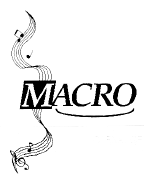
| Chromatic Harmonies |
| Dominant Seventh Chord |
| Harmonic Progression |
| Introduction to the Macro Technique |
| Leading Tone Seventh Chords |
| Modulation |
| More to think about |
| Nondominant Seventh Chords |
| Secondary Dominants |
| Slurs |
How to Teach Macro Analysis
We suggest presenting the steps to learning macro analysis in the following order.
Step I - Introduce and/or review the three main tools involved in macro analysis.
-
- Letter names:
- Major triads are represented with uppercase letters.
Minor triads are represented with lowercase letters.
Diminished triads are represented by lowercase letters followed by a "° " sign,
Augmented triads are represented by uppercase letters followed by a "+" sign.
- Roman numerals: This system of analysis employs the standard system of Roman numerals, including inversion numbers.
- Slurs: Slurs are used to connect all progressions that move by ascending fourth or descending fifth.
Ideally your students will already have covered letter names and Roman numerals in other contexts. The student then only needs to add knowledge of how to use the slurs to make the system complete.
Step II - Using the tools of macro analysis
-
First analyze the entire portion of music with letter names only.
When examples are short or straightforward, this seems like an extra step to some students, but as examples become longer or more complicated, this step is very helpful. From a pedagogical standpoint, this step is by far the most critical. Often tremendous improvement in both speed and accuracy results for students who had difficulties once they incorporate this step into their analysis.
- Then go back and determine Roman numerals. Once the students are looking at a letter-name representation of a chord it also helps them to identify secondary dominants and modulations.
- Add slurs and/or any other required analysis* to show forward motion.
Step III - Helpful suggestions
-
Suggest to your students that they think of the system in two parts:
The upper line of the analysis is the non-traditional part of the analysis. It includes letter names, slurs, and any other markings that you require.
The lower line of the analysis is the traditional analysis using Roman numerals and inversion numbers.
-
It is often helpful to explain to the student that each of the two lines of the analysis provide information which is not included in the other line. The Roman numerals state the tonic and the position of every other chord in relation to the tonic. The letter names give the specific pitch that each chord is built on. The slurs illustrate forward motion from one chord to the next. As an example, if you looked at measure 56 in an analyzed piece of music and saw a Roman numeral iii, you would know at a glance that is was a minor triad, but you would have to look at the actual notes themselves to know that it was an E minor triad in the key of C. By including both lines of macro analysis, all of that information would be available without looking at the score itself.
* The macro-analysis system is specifically intended to be very flexible. You may wish to have your students also mark various other progressions, such as those that move by thirds, or stepwise progressions. The system allows the instructor to tailor the analysis to the specific needs of the student and/or to the instructor's own requirements for analysis.
If you would like more information on any aspect of macro analysis including instruction, please send an e-mail to Jamie Henke.